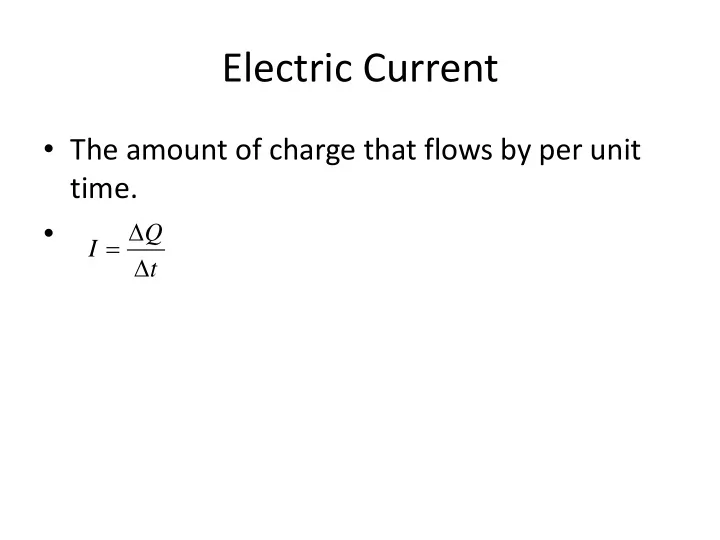

Electric Current • The amount of charge that flows by per unit time. • Q I t
Steady state • A system (e.g. circuit) is in the steady state when the current at each point in the circuit is constant (does not change with time). – In many practical circuits, the steady state is achieved in a short time. • In the steady state, the charge (or current) flowing into any point in the circuit has to equal the charge (or current) flowing out. – Kirchhoff’s Node (or Current) Rule.
n = number of charges per unit volume = “charge - number density” (n > 10 27 m -3 for a good metal) Typically v d ~ 10 -5 m/s ~1 m/day Figure 25.26
Why do the electrons have a drift velocity? • They feel a force due to an electric field. • But then they should accelerate!: F = ma • Each electron does accelerate for some time but then it collides with something (a nucleus, another electron, etc.). • After the collision, the electron goes off in some random direction, giving it momentarily a zero average velocity. • The drift velocity is the average velocity in the a F qE time between collisions: v d 2 2 m 2 m
Which of the following statements is false ? 1) An electric field is needed to produce an electric current. 2) A potential difference between two points is needed to produce an electric current. 3) For a steady current to flow in a wire, the wire must be part of a closed circuit. 4) The electric field is constant along all parts of the circuit when a steady current is flowing. 5) The electric current in a wire is proportional to the drift velocity of the charges.
Ohm’s Law • Current through a resistor (ohmic device) is proportional to the potential difference across it. V IR qE v d 2 m I qnAv d 2 q nAE I 2 m 2 q nA V I 2 m l
Resistance and Resistivity • Resistance depends on the geometry of the resistor – its length and cross-sectional area – R is proportional to length – R is inversely proportional to area. r l R A • Resistivity r depends on material properties like how often charges scatter.
Wire A , which is of the same length and material as wire B , has twice the diameter of wire B . If the resistance of wire B is R , what is the resistance of wire A ? 1) R 2) 2 R 3) R /2 4) 4 R 5) R /4
Emf • Emf (Electromotive “force”) – the voltage provided by some voltage source (e.g. a battery). • A source of emf converts non-electrical energy to electrical energy. • E.g. electrical generator (turns mechanical energy into electrical)
1) I 1 R 1 = I 2 R 2 Which of the relations 2) I 3 R 3 = I 4 R 4 among the quantities in the 3) I 1 R 1 = I 4 R 4 figure is generally correct? 4) I 3 R 4 = I 4 R 3 I 1 R 1 + I 2 R 2 = e 5)
Power in a circuit E • Power: P t • In time t, a charge Q enters on the left and Q exits on the right. V b V a
Recommend
More recommend